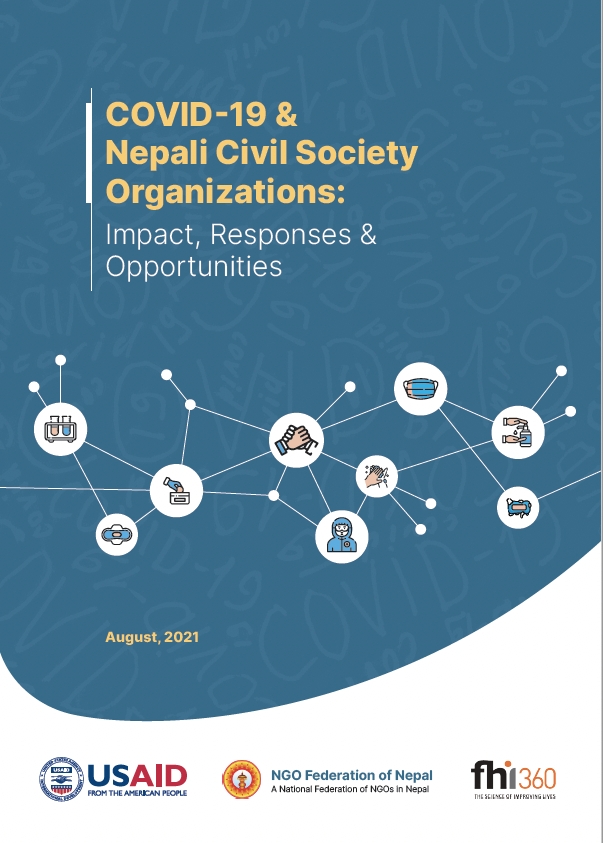This study documents the impact of COVID-19 on Nepali CSOs.
Executive Summary
Impact on CSOs
- Eighty-seven percent of CSOs reported a reduction in their ability to deliver programs and services. As the situation of pandemics improved, organizations also reported a slight improvement in their ability to provide services. While there was a slight improvement in the capacity of CSOs, 58 percent of CSOs still reported a decline in their ability to deliver regular programming.
- Fourteen percent of the organizations reported their program/services came to a complete halt. This is an alarming finding. This indicates that approximately 1400 CSOs have not provided their program and services for nearly a year.
- Advocacy-oriented organizations reported a slightly greater impact on their ability to deliver regular programs and services.
- COVID-19 has affected the registration of new CSOs. There was an 89 percent decline in new CSO registration in 2076-2077 than 2075-2076. Similarly, there was an 8 percent decline in new project approvals.
Concerns
- Six out of ten CSO expressed were worried they would not meet the registration/renewal deadlines.
- Four out of ten CSOs were either moderately or very concerned they might have to lay off their employees over a long period. Similarly, half of the organizations are concerned they will not be able to pay their operating expenses.
- Half of the CSOs are concerned that they will not be able to manage the increased demand for their services. Similarly, more than half of the CSOs are also worried that they will not be able to meet face-to-face with the community they serve.
- Most CSOs have switched to special AGM or online AGMs due to restrictions.
Funding
- Only four out of ten CSOs received some form of funding to carry out covid response activities.
- Ten percent of the SWC approved projects were for COVID-19 response and recovery in FY 2076-2077. The approved projects accounted for 1.3 percent (USD 2.02 million) of the total approved budget of USD 151.85 Million.
- Despite the growth in number, the percentage approved for COVID-19 is relatively lower than other projects. Only 5.1 percentage of the total approved amount was for COVID-19. The relatively larger number of projects and a smaller share in amount indicate relatively smaller-sized and fragmented projects for COVID-19.
- Sixty-eight percent of the funded organizations received funding from INGOs, followed by 33 percent from the government and 24.7 percent from the membership fees.
- The share of funding from the INGOs increased by 14 percent compared to the organization’s budget last year. On the other hand, the percentage of funding from the government declined by 17 percent.
- Funding from private organizations increased by 5 percent during COVID-19. However, in totality, the contribution of the private sector for CSOs remains relatively low.
- There is a bias towards service delivery organizations when it comes to funding. For example, 71 percent of service delivering organizations received grants from INGOs compared to 56 percent of advocacy organizations.
- Six out of ten organizations’ donors encouraged them to speak freely on the issues and challenges their organization and communities were facing and sought areas they could help.
- Only one out of ten organizations felt that their donor demonstrated any commitment to invest in strengthening the organization’s digital capacity and infrastructure.
CSO Response
- Nepalese CSOs contributed approximately USD 30 million during the first wave of covid outbreaks.
- Over 400,00 volunteers contributed voluntarily during the pandemic. Similarly, approximately 50,000 paid staff were involved in response and recovery during the first wave of covid-19.1.
- The CSOs provided approximately 15700 sets of PPE and other sanitation kits during the first wave of the pandemic.
- The top three response activities include: distribution of sanitation kits, generating awareness, and sensitizing communities.
- Eight out of ten CSOs reported serving people from the Dalit community. Similarly, six out of ten CSOs provided support to indigenous people.
Perception on the response from the government
- CSO leaders, in general, are not very satisfied with the government on their covid containment measures. On a scale of 1 to 5, the mean satisfaction score was 2.74, indicating a relatively lower level of satisfaction.
- CSOs in province 2 reported the lowest level of satisfaction. On the other hand, CSOs from Karnali province expressed a better level of satisfaction.
- CSOs expressed they were relatively more satisfied with the local governments’ effort than the provincial and federal governments.
Perception on freedom of expression and association
- Respondents from provinces one, two, Bagmati, and Karnali, perceived better freedom of expression compared to Lumbini, Gandaki, and Sudurpaschim province.
- Urban CSO leaders felt better freedom of expression compared to their rural counterparts.
- Smaller (< 25) and medium-sized organizations (25 – 50) leaders felt better freedom of expression compared to the leaders of larger organizations (> 50).
- Organizations working in advocacy were more critical of the state of freedom of expression compared to service delivery organizations. Similar differences were observed between female-led organizations and male-led organizations, where females were more critical than men.
Emerging opportunities
- Six out of ten organizations networked with fellow CSOs and conducted several online meetings and charted the course for their response.
- Some organizations have created loose networks among the organizations to offer innovative solutions during the pandemic.
- More than half of the organizations also prepared a post-pandemic operational strategy for their organization.
- One in three organizations also accelerated the adoption of digital technologies for their work.
The full report can be downloaded from here: https://pdf.usaid.gov/pdf_docs/PA00XX8M.pdf
